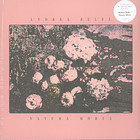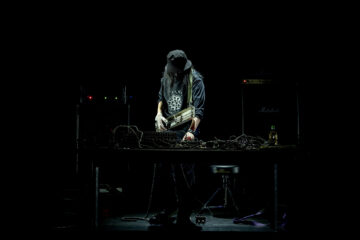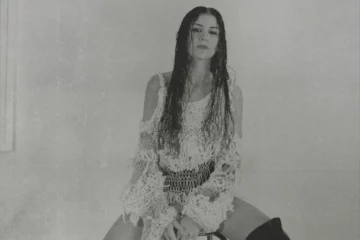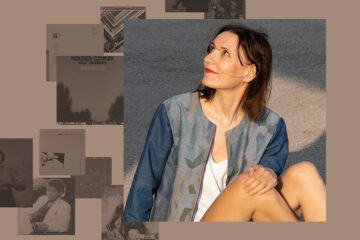Andrea Belfi sips his juice and glances down briefly before turning his head to the left. He takes another sip of his orange juice and says, »Drummers have a unique perspective on music«. This perspective might just be popular right now. Belfi pauses, recognising that the question isn’t so simple to answer as he first thought. Valentina Magaletti, Niklas Wandt, Kahil El’Zabar and Chris Corsano are all drummers who are gaining prominence in underground and experimental circles today. Have drummers gained more significance in contemporary music compared to the past?
Andrea Belfi’s name would certainly have fit well into this line-up too. After all, the Verona native has managed to carve out a niche for himself over the last few years by performing with great artists, including Nils Frahm, Thom Yorke from Radiohead, and hardcore icon Mike Watt. This is the topic we chose to begin our interview with him in a café in Sankt Vith. The night before, Belfi had given an outstanding solo performance at the East Belgian Weekender Festival which saw him wandering between synthesiser and drum kit and a number of other percussion instruments. A powerful sonic experience, sometimes reminiscent of early explorations by Fuck Buttons, into creating tribal noise with drums.
This is presumably a far cry from when he took his first steps in Verona at the age of 14. Back then, he was a skater who also wanted to form a band on the side. Born in 1979, the 44-year-old taught himself to play the drums, joined the Italian hardcore scene in the 1990s and, after several detours (and art studies), ended up in a music scene somewhere between jazz, improvisation, experimental, avant-garde and marginal pop – and was on some of the biggest stages during Thom Yorke’s »Anima« tour. This makes him one of the prototypes of the new drumming scene: with one foot still on the drum pedal, and the other conquering the whole world of music.
We’ve already met once before: In 2013, when I was working there as a booker, you performed at a club in Cologne with Il Sogno Del Marinaio. Behind the band name was a group of three musicians, including yourself and the (hardcore) punk legend Mike Watt (of The Minutemen, Fire Hose, and Stooges fame). So What brought you together?
In 2009, Watt and I agreed to form a trio with guitarist Stefano Pilia and perform some gigs in Italy, as well as record in the studio. These short tours were then followed by two longer tours in Europe, a particularly lengthy tour across the United States, two albums and three singles. Despite the age and experience gap between us and Mike, a profound musical and moral connection was established, both artistically and on a personal level.
Let’s begin with your early music experience: You began playing drums at the age of 14. How much support did you get from your friends and family back then?
I definitely pissed off the whole neighbourhood. (laughs)
We’re talking the mid-nineties here and suddenly you find yourself in the Italian punk and hardcore music scene. In Germany, hardcore is seen as more of a genre that was not and is not necessarily played in the big cities with their millions of inhabitants, but is instead decentralised. So where was it and is it played in Italy?
During the 1990s, the hardcore punk scene was predominantly prevalent in the Veneto and Emilia Romagna (Padua, Modena, Treviso, Carpi) areas, but also in some other places, like Turin and Milan. There were lots of squats, and smaller festivals where everyone knew each other; lots of fanzines, smaller labels… a lot of action and energy. After almost a quarter of a century, I meet some people who were drawn to this scene and many of them have embarked on pathways linked to music and the art world in general, not just careers, but very interesting artistic pathways.
»The key is to avoid tricks or special effects, and instead concentrate on the sound.«
Andrea Belfi
Where were the gigs put on back then? Were they proper venues or your typical run-of-the-mill squat?
The scene was very political and very left-wing, so we really only played in squats. This is where people used to hang out. The towns and cities–like my home town of Verona, for one–tend to be right-wing and/or Catholic, and then you have these small anarchist islands. The main thing was that the different scenes were not closed off. Lots of different musicians met and exchanged ideas, spent time playing together. That had a big impact on me.
Were they all DIY scenes?
Yes, exactly. There were punk bands playing, noise, emo… I don’t know if I would still listen to it much these days, but people were open and…
…and that encouraged you to just go for it?
Definitely. And then there was the exposure to other bands that gave me access to other types of music. The post-rock band Gastr del Sol is worth mentioning more than any other. And David Grubbs and Jim O’Rourke, two other musicians, introduced me to other artists: the band Faust, John Zorn and others.
And you didn’t go to music conservatory, either, but instead, to the art conservatory in Milan.
Yes, I really wanted to study under Alberto Garutti. He was one of the very few contemporary art lecturers around at the time.
This was before the time of »sound art« and »intermedia art« classes. And what did you do there?
Music and sound art more than anything else, but I didn’t take any special classes. That’s right. That’s why it was so important for me to study under Garutti. No one else knew how to approach these new genres.
Let’s move on to where you are today: Yesterday you played a gig at the Weekender Festival in Saint Vith. Frankly, it’s hard for me to really classify everything you’ve done out of all the things that have come together. Maybe I can break it down by looking at the different collaborations you’ve worked on – or at least partially: The chord progressions and the synth sound remind me of Thom Yorke’s solo work. And then there is a certain New Mastery opulence to it, which can also be heard in the work by Nonkeen – your project with Nils Frahm.
That’s an interesting observation. I think that’s something that survived the DIY era: you try to be as individual as possible. And at the same time you have certain references or points of connection in your mind. These are things you can’t separate.
But you also play the drums to the synthetic sound sources. This includes your own version of the trimba, the percussion instrument created by blind composer and street musician Moondog. I found that pretty interesting because it sounded like a one-man band, like one person performing alone as a trio.
Yeah, sure… (he hesitates)
But you have a problem with the description of a one-man band?
I find the animations, sounds and built-in games good. Everything’s fine as long as I don’t start singing (he laughs). The key is to avoid tricks or special effects, and instead concentrate on the sound.
»There is a very Italian sensibility for the melancholic side of music, a certain dramaturgy that is very present in folk and pop songs, and from a certain kind of hedonism as well, I think.«
Andrea Belfi
At the same time, you don’t perform any of the songs from your last album »Eternally Frozen«, which was released on the Italian label Maple Death Records. Why is that?
To be honest, I’m not quite there yet. I am currently working on an interpretation of the album. Because the horns play such an important role in the compositions on »Eternally Frozen«, I didn’t want to resort to playback. I will play an »Eternally Frozen« gig soon, though. But only with a trombonist.
The album is different from your previous albums. It’s more classical, romantic at times. What were the influences on the LP which saw you breaking new ground?
For me, the focus was on working with the horns. That was definitely the starting point for everything. I was very drawn to the sound of Zinc & Copper, the trio that includes Robin Hayward and Elena Kakaliagou, two of the musicians who play on Eternally Frozen. I heard her live with Catherine Christer Hennix and then on vinyl on Ellen Arkbro’s ›For Organ and Brass‹. William Basinski’s »Disintegration Loops« also inspired me. I had the loose idea that the music on »Eternally Frozen« could be something like the original tapes from the Basinski project.
Let me come back to the one aspect I just mentioned: One could almost get the impression that you are preoccupied with »new mastery«, with neo-classical gestures…
There was a time when I was associated with some of the artists from that scene. But it had more to do with me working with Nils Frahm on various projects than anything purely musical. As for »Eternally Frozen«, I guess I could say that there might be a certain connection. But my sensibility makes me associate this record of mine more with past listening experiences, such as the 1990s records from the band Rachel’s, and also with folk music more than classical music.
Related reviews
Last but not least, I want to turn to your homeland, Italy: I find it interesting that the canon, which plays a very important role in the structure of »Eternally Frozen«, can be found in your work in particular, but also in the work of Lorenzo Senni and Caterina Barbieri. Do you think there’s a connection there?
I’ve never really thought about it before. But I suppose the answer can only be yes: There must be a connection. I think there is a certain awareness of this old form.
Does it come from the church and religious chants?
Perhaps not directly from the church, but from the background of Italian popular culture. I think there is also an Italian sensitivity to the melancholic side of music, something that comes from Morricone’s music, say, to a certain dramaturgy that is very present in folk and pop songs, and I think also from a certain kind of hedonism.














